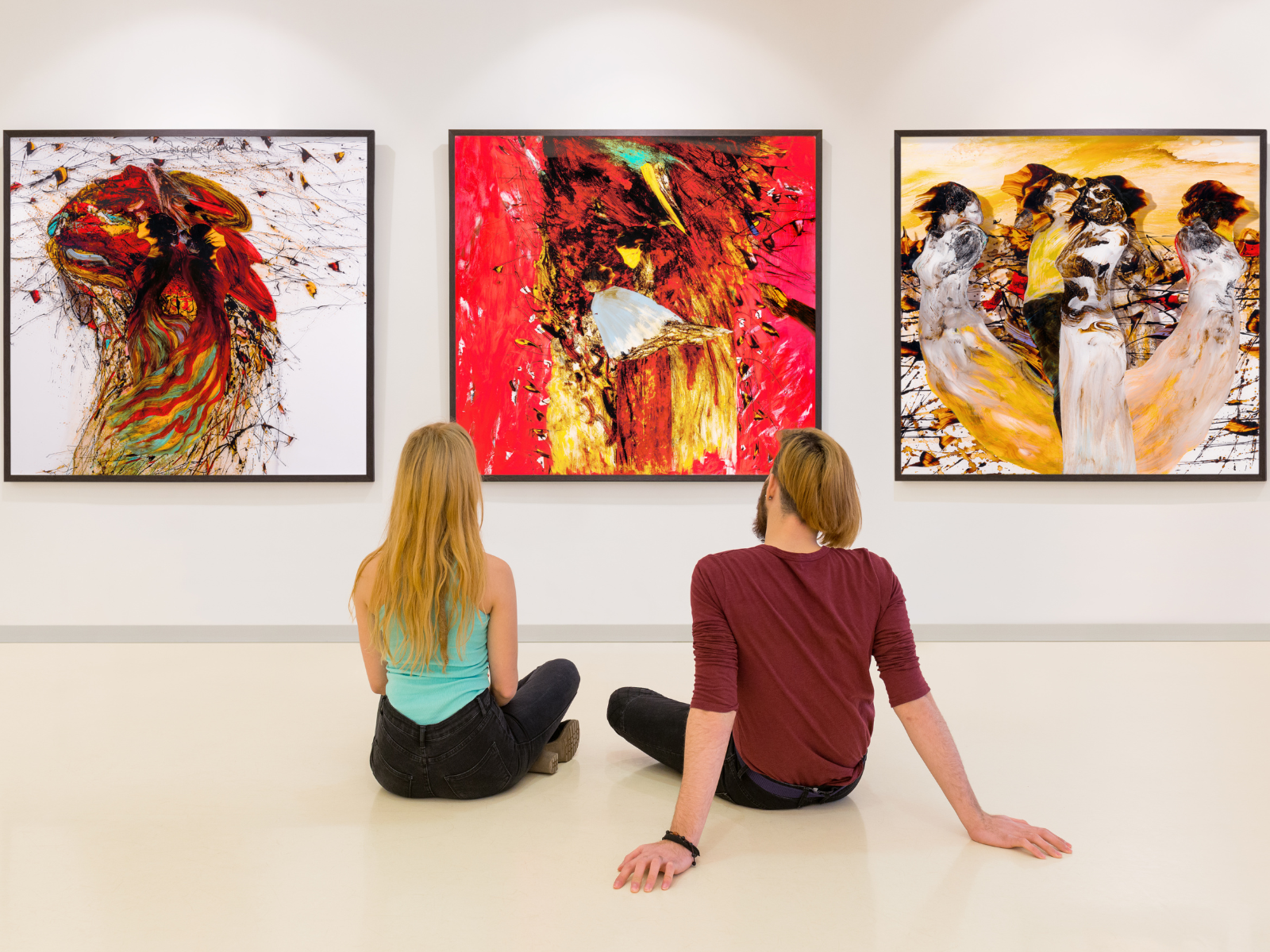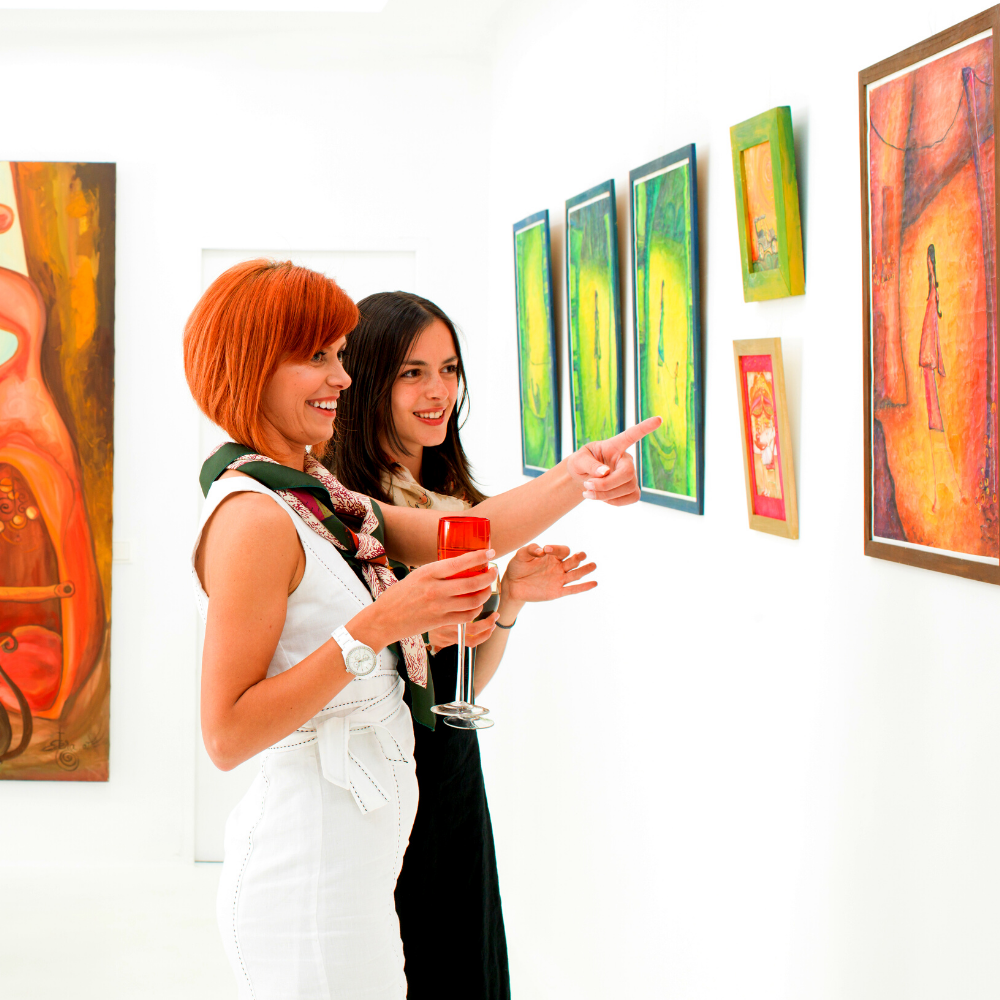Have you ever stood in front of a masterpiece, mesmerized by its beauty and wondering how the artist created such a stunning piece?
Or perhaps you've attended an art show or gallery opening and found yourself struggling to comment on the works displayed.
As artists, we all have our own unique preferences, styles, and techniques – making it difficult for us to objectively evaluate another artist's work.
From the bold strokes of a master painter to the intricate details of a sketchbook doodle, art comes in all forms and can evoke a wide range of emotions.
As artists, we pour our hearts and souls into every piece we create, but once it's finished, how do we know if it truly measures up?
Evaluating art is an art form in itself; it can be challenging to know how to evaluate your own creations, let alone someone else's.
Whether you're just starting your artistic journey or have been honing your craft for years, learning how to evaluate your own work and give constructive critiques can greatly improve your skills as an artist.
From analyzing composition and color choices to understanding symbolism and artistic intent, get ready to elevate your art evaluation skills in no time!
So, grab your favorite beverage and get ready to dive into this ultimate guide on how to art critique like a pro!
Get ready to sharpen your eye for detail and gain a deeper understanding of the artistic process!
Key Takeaways:
- Understanding the various criteria for evaluating art, including technical skill, emotional response, and cultural significance.
- Recognizing the importance of context in art evaluation, such as art history, the art market, and the artist's intent.
- Learning practical approaches to art criticism and how to apply them to both abstract and representational art.



Art and Art Criticism
There's no denying that the world of art is subjective and can be interpreted in countless ways.
From traditional oil paintings to abstract sculptures, each piece has its own unique story and message.
As artists, we pour our heart and soul into creating these works, and art criticism can seem overwhelming, with so many factors to consider.
But evaluating a piece of art should be fun and engaging, not intimidating!
Art evaluation is a nuanced process that involves a blend of subjective interpretation and objective analysis.
Whether you're an art consultant, collector, or simply an enthusiast, knowing how to evaluate a piece of art is essential.
You'll not only gain a deeper appreciation for the work, but you'll also be able to make informed decisions about which pieces to add to your collection or include in your creative projects.
Let's define what we mean by "evaluate" when it comes to art.
Evaluating a piece of art means critically analyzing its components and characteristics in a subjective way.
This means that there is no one right way to evaluate art. Instead, it's up to you as an individual to decide what elements of a piece are most important and how they make you feel.
You might evaluate a piece of art based on technical proficiency, emotional resonance, or its ability to communicate a message.
The Role of Technical Skill in Art Evaluation
When evaluating art, one of the first aspects to consider is the technical skill involved in creating the work.
This includes the artist's mastery over their chosen medium, whether it's the delicate brushwork of oil paintings or the precision of a drawing.
The technical skill can be observed in the way an artist manipulates materials, the cleanliness of their technique, and their control over the elements of composition such as line, form, and color.
Technical skill also extends to the artist's ability to use perspective and create a convincing picture plane.
For example, the use of linear perspective in a landscape painting can reveal the artist's proficiency in creating depth and dimension on a flat canvas.
The Metropolitan Museum of Art often showcases works that exemplify exceptional technical skill, from old masters to contemporary artists.
By studying these works and analyzing the techniques used, we can gain a better understanding of the art elements that contribute to technical mastery.
Emotional Response and Personal Taste
Evaluating art is not solely about technical prowess; the emotional response a piece elicits is equally important.
Art that resonates on an emotional level can be considered successful, regardless of its technical merits.
Personal taste plays a significant role here, as what moves one viewer may not affect another. This subjective aspect of art evaluation is what makes the experience of viewing art deeply personal and unique.
The emotional impact of a work of art can be influenced by its subject matter, the colors used, or the overall mood it conveys.
For instance, the somber tones and expressive brushwork in Van Gogh's paintings often evoke a strong emotional response.
Similarly, the bold colors and dynamic forms of pop art can elicit feelings of excitement or nostalgia.
Contextualizing Art within History and Culture
Art does not exist in a vacuum; it is a product of its time and reflects the cultural significance of the era in which it was created.
When evaluating art, it's crucial to consider the historical context and the cultural narrative that the artwork represents.
This includes understanding the art movements that influenced the artist, such as abstract art or pop art, and how their work contributes to or deviates from these traditions.
Art history provides a framework for understanding the evolution of artistic styles and the impact of different cultural periods on the art produced.
For example, the Renaissance period's emphasis on humanism and naturalism can be seen in the lifelike figures and detailed landscapes of that time.
Similarly, the social and political commentary inherent in much of contemporary art reflects current global issues and societal trends.
The Art Market and Investment Value
For many, evaluating art also involves considering its market value and potential as an art investment.
The art market is a complex entity, influenced by factors such as rarity, provenance, and the reputation of the artist.
When assessing the value of a piece of art for investment purposes, it's important to research recent sales, both at auction and in private sales, to gauge the artwork's current and projected worth.
Art consultants and investors often look at the track record of an artist's sales and the demand for their work among collectors.
The market value of a piece can fluctuate based on trends in the art world, making it a dynamic and sometimes unpredictable element of art evaluation.
For example, the works of emerging artists may see a surge in value as they gain recognition, while established artists' works can be considered more stable investments.
The Significance of Subject Matter and Themes
When we evaluate art, the subject matter and underlying themes play a crucial role in its appreciation and critique.
Generally speaking, the subject matter refers to the primary visual focus of the artwork, whether it's a figure, a landscape, or an abstract concept.
For instance, the 'Mona Lisa' is renowned not just for Leonardo da Vinci's technical prowess but also for its enigmatic subject.
The themes, on the other hand, delve deeper into the ideas and messages the artist intends to convey.
This could range from social commentary to personal expression, and understanding these themes can significantly enhance one's appreciation of the artwork.
In evaluating your own artwork or that of other artists, it's important to consider how effectively the subject matter and themes resonate with the viewer.
Are they compelling, thought-provoking, or emotionally stirring?
For example, a series of still lifes may explore the theme of mortality through the depiction of decaying fruit, an idea that has been revisited throughout art history.
By examining these aspects, an art critic can provide a more nuanced analysis that goes beyond the surface-level aesthetics.
The Impact of Presentation and Display
The way artworks are presented and displayed can greatly influence how they are perceived and evaluated.
The structure of the display, the lighting, and even the framing can alter the viewer's experience.
For example, photography displayed with ample negative space around it can emphasize the focal area, drawing the viewer's attention more effectively to the intended subject.
In a private sale or gallery setting, the presentation is meticulously planned to showcase each piece in the best possible light, literally and figuratively.
Moreover, the context in which art is displayed can add layers of meaning or alter its interpretation.
When evaluating art, it's important to note the environment and how the artwork interacts with it.
A sculpture placed in a busy public square might be evaluated differently than if it were in a serene garden.
The surroundings can either complement or detract from the artwork, and this interplay is an important aspect to consider when forming an opinion about a piece.
Whether evaluating your own work or that of others, remember that presentation can be as impactful as the artwork itself.
The Significance of Provenance in Art Evaluation
When evaluating a piece of art, provenance, or the artwork's history of ownership, is an important aspect that can significantly affect its value and authenticity.
Provenance can provide a fascinating glimpse into the artwork's journey through time and the hands of various owners.
It can also serve as a point of interest that adds depth to the story of the piece.
For collectors looking to own art with a rich history, provenance is a key factor to consider.
It can also help in confirming the legitimacy of a work, as a well-documented provenance can be a strong indicator that the piece is not a forgery.
In addition to its impact on value and authenticity, provenance can also influence the cultural and historical significance of an artwork.
For example, a painting that was once part of a renowned artist's personal collection or displayed in a prestigious exhibition may carry more weight in the eyes of collectors and historians.
This background can make the artwork more interesting and desirable.
When evaluating art, it's beneficial to research and understand the provenance, as it can provide insights that are not immediately apparent from the artwork alone.
Incorporating Art Criticism and Reviews
Art criticism and reviews are valuable tools for understanding and evaluating art.
They offer perspectives from individuals who have studied art extensively and can provide informed opinions on the technical and conceptual aspects of a piece.
Reading reviews from respected critics can offer a few tips on what to look for in a piece of art and can highlight important aspects that may not be immediately obvious to the casual observer.
Critics often discuss the artist's technique, the themes and messages within the work, and its place within the artist's body of work or within the broader art movement.
Moreover, art criticism can serve as a guide for personal art appreciation and can challenge viewers to see beyond their initial impressions.
Critics often provide interesting examples that illustrate their points, helping readers to engage with art on a deeper level.
It's important to remember, however, that criticism is subjective, and one critic's point of view is not the definitive interpretation of an artwork.
Engaging with a variety of opinions and reviews can enrich one's own understanding and appreciation of art, leading to a more nuanced and personal connection with the piece.
Influence of the Patron & Commissioning Body
The relationship between the artist and the patron or commissioning body can significantly influence the creation and evaluation of art.
Patrons have historically played a crucial role in the art world, often dictating the subject, style, or purpose of a piece.
When evaluating art, understanding the patron's influence can provide insight into the artwork's intended message and societal value.
For instance, Renaissance artworks commissioned by the Church are imbued with religious significance and crafted to convey specific theological principles.
Moreover, contemporary art often reflects the vision of corporate or institutional patrons, which can be seen in public installations and corporate collections.
The dynamics between the artist and the patron can reveal the economic and political context of the artwork, adding another layer to its interpretation.
As such, the patron's identity and motives are essential factors to consider when assessing the significance and purpose of a piece of art.
The Significance of Provenance in Art Evaluation
When evaluating a piece of art, the provenance, or the history of the artwork's ownership, can be as telling as the artwork itself.
Provenance can authenticate a piece, linking it to well-known collectors or historical figures, which often adds to its value and desirability.
A well-documented provenance can serve as a testament to the artwork's legitimacy, ensuring that it is not a forgery or stolen.
Art experts and historians meticulously trace the lineage of ownership through auction records, gallery sales, and even inventory lists from estates.
Moreover, provenance can provide a narrative that enriches the artwork's significance.
For instance, if a painting was once part of a prestigious collection or was a personal favorite of a historical personage, this backstory can captivate potential buyers and art enthusiasts alike.
It's not just about the artwork's physical journey through time and space; it's about the story it tells and the lives it has touched.
This historical breadcrumb trail can significantly influence an art piece's market value and cultural importance, making it a critical aspect of art evaluation.
Interdisciplinary Approaches to Art Criticism
In the realm of art criticism, interdisciplinary approaches have become increasingly prevalent, offering a more holistic understanding of artworks.
By incorporating perspectives from various fields such as sociology, psychology, philosophy, and even science, critics can uncover layers of meaning that might otherwise go unnoticed.
This method allows for a more nuanced critique, considering not only the visual aspects of the artwork but also its broader implications and the societal context in which it was created.
For example, a painting might be analyzed not just for its aesthetic qualities but also for its psychological impact on the viewer, the philosophical questions it raises, or its commentary on social issues.
An interdisciplinary critique can reveal how an artist's choice of materials reflects technological advancements or environmental concerns.
By engaging with art on multiple levels, critics can offer a richer, more comprehensive evaluation that resonates with a diverse audience and provides deeper insights into the human condition.
Interpreting Symbolism and Iconography in Art
Delving into the symbolism and iconography of an artwork offers a profound layer of understanding that goes beyond the superficial.
Symbols and icons can be deeply entrenched in the cultural, religious, or political milieu from which the art emerged, providing insights into the era's zeitgeist.
For instance, the use of certain colors, figures, or motifs might convey specific meanings that were widely recognized by contemporaries but may require translation for the modern viewer.
A person knowledgeable in these symbolic languages can unlock a treasure trove of meaning in even the most enigmatic pieces.
In addition to cultural symbols, personal iconography used by the artist can also be a key to interpreting their work.
Artists often imbue their creations with personal symbols that serve as signatures or convey intimate or autobiographical elements.
For example, the recurring motifs in Frida Kahlo's paintings often represent her personal experiences and heritage.
Understanding these symbols can transform the viewing experience, allowing the person to connect with the artist's inner world and the broader cultural context in which they lived and worked.
The Psychological Impact of Art and Aesthetics
Art possesses the profound ability to affect the human psyche, eliciting a wide range of emotional and cognitive responses.
When evaluating art, it is important to consider its psychological impact, which can be as significant as its aesthetic appeal.
Artworks that resonate on a psychological level often become iconic, shaping the collective consciousness and influencing cultural narratives.
For example, Picasso's "Guernica" not only demonstrates masterful technique but also evokes a powerful emotional response due to its depiction of the horrors of war.
Furthermore, the aesthetics of an artwork—its colors, forms, and composition—can have a direct effect on the viewer's mood and mental state.
The use of color theory and geometric shapes can be analyzed to understand how an artwork communicates and influences perception.
In this regard, art evaluation transcends mere visual appreciation and delves into the realm of psychological analysis, where the personal experiences and subconscious reactions of the viewer become part of the artwork's overall impact.
The Artist's Intent and Vision
Understanding the artist's intent is a key component of evaluating art.
An artist produces work with a certain vision or message in mind, and grasping this concept can enrich the viewer's appreciation of the artwork.
The artist's background, experiences, and the chosen subject matter all contribute to the narrative they wish to convey through their art.
In some cases, the artist's intent may be explicitly stated, while in others, it may be open to interpretation.
For instance, the symbolism in a piece of abstract art may not be immediately apparent, but learning about the artist's philosophy and inspirations can provide valuable insight into the meaning behind the work.
While personal interpretations of art are valid, understanding the artist's intent can offer a deeper connection with the piece and provide a more comprehensive evaluation.
Formal Qualities and Composition
The formal qualities of an artwork, such as its composition, color scheme, and use of space, are fundamental aspects to consider when evaluating art.
A well-composed work will guide the viewer's eye across the canvas, creating visual interest and balance.
The arrangement of elements within the picture plane, such as the placement of figures, shapes, and focal areas, contributes to the overall impact of the piece.
Composition also involves the interplay of light and shadow, the juxtaposition of different forms, and the harmony or contrast of colors.
For example, the strategic use of light in a still life can highlight important details and create a sense of realism, while the bold, flat colors of pop art can emphasize graphic quality and visual impact.
The Use of Medium and Materials
The materials and techniques an artist chooses to work with can greatly affect the final outcome of their artwork.
Different mediums offer various textures, finishes, and possibilities for expression.
For example, the fluidity of watercolors allows for soft, ethereal effects, while the versatility of acrylics can be used to create both delicate details and bold, textured strokes.
The choice of canvas, paper, or other surfaces also plays a role in the artwork's texture and how the medium interacts with the background.
Additionally, the use of non-traditional materials or mixed media can add an innovative dimension to the work, challenging traditional notions of what constitutes art.
Understanding the artist's use of medium and materials can provide a deeper understanding of their creative process and vision, contributing to a more thorough evaluation of the artwork.
The Role of Context in Art Evaluation
The context in which an artwork was created or is displayed can significantly impact its interpretation and evaluation.
For instance, seeing an iconic piece in person at a museum versus viewing it in a textbook or online can elicit different responses and insights.
The physical setting, lighting, and proximity to other artworks can all influence the viewer's experience.
Furthermore, considering the historical and cultural context in which an artwork was created is essential for understanding its significance.
Art is often a reflection of its time, responding to societal changes, political events, and cultural movements.
By understanding the context in which an artwork was created, viewers can gain a deeper appreciation for its relevance and impact.
Viewing Art from Different Angles
Evaluating art is not a static process; it can be beneficial to view a piece from different angles and in varying lights to fully appreciate its qualities.
The way light interacts with the surface of a painting or sculpture can change the viewer's perception of color, form, and texture.
Moving around a piece of sculpture or viewing a painting from different vantage points can reveal new details and aspects of the work that may not be immediately apparent from a single perspective.
This approach to evaluating art encourages a more immersive and interactive experience, allowing the viewer to engage with the work on a deeper level.
It also highlights the importance of the physical space in which the artwork is displayed, whether it's a gallery setting or a more intimate environment.
Ongoing Process of Art Evaluation
Evaluating a piece of art is a multifaceted process that encompasses technical skill, emotional response, cultural significance, and much more.
It is an ongoing dialogue between the viewer and the artwork, with each interpretation and evaluation adding to its ever-evolving narrative.
By taking into account various factors such as patronage, provenance, interdisciplinary approaches, symbolism, aesthetic impact, artist's intent, composition, medium and materials, context, and viewing perspectives, one can gain a richer understanding of an artwork's meaning and value.
Ultimately, art evaluation is a subjective experience, influenced by personal perspectives and biases.
However, by engaging with art on a deeper level and considering multiple aspects of its creation and reception, one can develop a more nuanced and multifaceted appreciation for this enduring form of human expression.
And in this ongoing conversation between viewer and artwork lies the true beauty and significance of art.
It challenges us to question our preconceived notions and look beyond the surface to discover new perspectives and insights.
Through this guide, we've explored the various dimensions of art evaluation, providing a comprehensive framework for analyzing and appreciating the vast world of visual art.
Evaluating art is a subjective and complex process, but it can also be incredibly enjoyable!
By analyzing the composition, color, texture, and context of a piece, while also paying attention to our emotional response and the opinions of others, we can gain a deeper understanding of the art world.
Keep these tips in mind the next time you're evaluating a piece of art, and remember to use specific language to describe your evaluation.
With practice, you'll become a pro at evaluating art in no time; happy critiquing!



Art Evaluation FAQs
Art evaluation and critique can be intimidating for those new to the art world.
To help ease your concerns, here are some frequently asked questions and answers about evaluating art.
What should I focus on when evaluating a piece of abstract art?
When evaluating abstract art, consider the formal qualities such as composition, color, and texture, as well as the emotional response it provokes. Researching the artist's intent and the context in which the artwork was created can also provide valuable insights into its meaning and significance.
How does the art market affect the evaluation of art?
The art market influences art evaluation by determining the market value of a piece, which is affected by factors like the artist's reputation, provenance, rarity, and demand among collectors. Market trends can also impact the perceived value of an artwork over time.
Can personal taste be considered a valid criterion for evaluating art?
Yes, personal taste is a valid and important aspect of art evaluation. While technical skill and cultural significance are objective criteria, the subjective experience of the viewer, including their personal taste and emotional response, is a crucial part of the art evaluation process. So, it is essential to acknowledge and consider personal taste while evaluating art. However, it should not be the sole determining factor.
How do I determine the value of a piece of art?
Determining the value of a piece of art can be complex and subjective. Factors such as technical skill, cultural significance, provenance, and current market trends all play a role. It can also be helpful to research the artist's background, influences, and intent behind the artwork. Ultimately, the value of art is determined by a combination of factors and can vary depending on personal perspectives and market fluctuations.
Is there a right or wrong way to evaluate art?
There is no right or wrong way to evaluate art, as it is a subjective experience. However, using specific language and considering multiple aspects such as formal qualities, context, and personal taste can provide a more comprehensive evaluation. Ultimately, the most important aspect of evaluating art is engaging with it in a meaningful way and learning from the experience.



Looking to start analyzing art? Check out Tomas Folan-Hasici's video!
Want even more content about creativity and art?
Be sure to check out all of our creative chronicles!
Eager to explore art, creativity, and critiquing?
Check out some of our other articles:
-Giving and receiving feedback
-What questions can you ask while evaluating art?
-What are 4 theories for judging your art?
-What are the 7 elements of art?










